Loyalty programs can play a strategic part in your enterprise’s growth plan. And they’re essential to delivering the personalized customer experiences today’s consumers expect.
According to Forrester’s January 2022 survey of Marketing VPs and above in North America, 73% of companies have a loyalty initiative. But how well are these programs performing—for both brands and their customers?
The loyalty landscape in North America
The biggest challenge for brands, according to Statista, is member participation as their survey revealed consumers actively engage with less than half of the loyalty programs they join. Interestingly, the survey also found that 52% of U.S. consumers report they’re likely to increase their participation in loyalty programs over the coming year. So, how do you ensure consumers choose to engage with your loyalty program over others?

Gartner’s 2023 Market Guide for Loyalty revealed that, while loyalty programs facilitate zero- and first-party data capture and engagement that enables brands to personalize experiences, organizations often struggle to use loyalty programs to their full potential. This guide is designed to help you identify areas of opportunity and improvement to help keep your loyalty program on your members’ go-to list while benefiting your bottom line.
5 common mistakes that prevent brands from maximizing their loyalty programs

Loyalty programs are a great way to differentiate your brand but, the reality is, most organizations aren’t doing anything unique. In fact, 80% of executives say their loyalty program is similar to others in their industry (PwC). For many retailers, the opportunity exists to take a closer look at loyal customers to understand where, when and why they buy.
Here are five common mistakes brands make that limit their ability to get the most out of their loyalty program.
1. Not having comprehensive goals
According to The Mallett Group’s Product and Solutions Director Steve Sickel, a lot of brands look at their goals from a one-sided perspective. Instead of marrying brand and commercial outcomes, most companies focus all their loyalty design and solution efforts around achieving commercial outcomes, or core business key performance indicators (KPIs). But they’re missing the opportunity to leverage their loyalty program as an enhancer, an accelerant, an extension of the brand’s value proposition. Too often, organizations view their loyalty program as an island, a machine that helps drive activation, SOWs, retention, cross-sells and upsells. While these are all important commercial outcomes, they don’t propel your brand’s core pillars in terms of purpose, positioning and personality—and this is where the true differentiation happens. A great loyalty program drives both commercial performance and brand value.
2. Trying to sign up every customer
Ascendant Loyalty’s Co-founder & Partner David Slavick advises his clients that not every customer is going to have a strong affinity to your brand. Some will always be occasional buyers. David cautions organizations about aspiring to have 99% of all transactors signed up for their loyalty program. That simply adds incremental costs and creates a large database of inactive customers while diverting focus away from the real opportunities.
3. Focusing on the wrong metrics
This is related to mistake number two above. According to David, brands should focus less on the number of loyalty members and more on increases in average transactions, units per transaction and margin—including comparing these metrics for members versus non-members. Tandem Theory’s SVP of Data Sciences, David Mansfield adds that it’s also important to regularly balance financial guardrails against member expectations for value and earning, including time to reward and reward value.
4. Not communicating the program’s value
Ascendant’s David Slavick sees too many brands promoting their loyalty program prior to member signup—and then crickets. Loyalty members need constant reminders of the value you’re offering and they’re receiving to continually reaffirm their decision to join and be loyal to your brand. One email isn’t enough. Members need time and guidance as they learn about how your program works and how best to make it work for them—especially if your program details around benefits and how they can earn and redeem rewards are even a little bit complicated.
5. Not integrating loyalty into their customer experience
The importance of the customer journey
Spencer Smith, VP of Strategic Growth at Bold Orange advises his clients that it’s essential to integrate the loyalty program into the very heart of the customer experience across all meaningful touchpoints. According to Spencer, success hinges on more than just a compelling value proposition; it necessitates a seamless infusion into the customer journey, creating an experience so well-orchestrated that customers don’t see it as a separate program. The greater the cohesion with the customer experience—the more profound and resonant the impact will be.
The customer experience lens
Ascendant’s David Slavick offers an example of what not to do—a high-end brand sending a birthday offer within five days of a member’s birthday that expires five days after their birthday. If it’s for a free scoop of ice cream, sure, but members need to plan and budget for big-ticket items, so a five-day expiration is too short. David offers that brands typically use a short redemption window because they think it’ll drive incremental traffic—but he advises that’s not the purpose of a birthday gift. It’s about celebrating the customer and making them feel special. Everything should be viewed through the lens of your customer’s experience.

9 traits of an effective loyalty program
So, how can your brand drive better business performance from your loyalty program while delivering a more rewarding loyalty experience to your members? As you read through our nine traits of an effective loyalty program, take note of how many you can check off your list and which ones might need a little TLC to get the results you want.

Trait #1: The program helps your brand achieve its goals
You know the old adage, ‘failure to plan is planning to fail’. Your loyalty program is no exception. It’s important to know what you want to achieve with your loyalty program and have a way to measure success.
Target audience specification
According to Jodi Rausch, Managing Director of Loyalty Solutions at Concentrix Catalyst, new or existing loyalty programs should help brands better prioritize and define the goals they want to achieve. For example, can we get more specific than simply ‘drive revenue’? Loyalty helps you look at how you can drive revenue by specific target audiences, by certain behaviors and more. In our Get Personal with Loyalty podcast episode, featuring Ansira’s EVP of Integrated Loyalty Sukumar Muthya, we talk about how loyalty programs can help you improve forecasting for your board, shareholders and overall business. If you know 80% of your purchases are loyalty member transactions, you have a wealth of knowledge that enables you to forecast more consistently as well as identify levers you can pull to ensure you hit that forecast.
Cross-organizational alignment
Andréanne Rondeau, Founder of stratLX, recommends brands make building and fostering customer loyalty a company-wide effort and adds that it’s likely to fail if it doesn’t have the buy-in of senior executives. She shares that successful businesses are adopting a strategic approach to customer loyalty. By creating cross-functional collaborative efforts between executives and teams in defining objectives and shaping loyalty strategies, there’s greater buy-in across the organization, resulting in a shared vision, common goals and better results.

Start with overall business objectives
Before diving in to identify the specific goals of your loyalty program, start with defining your overall business goals, which may include:

Align with marketing specific goals

Brand vision centricity
According to Adam Posner, CEO & Founder of The Point of Loyalty, a loyalty program needs to be clear on its responsibility to the brand goals it serves in order to achieve long-term success. While this may seem obvious, the nuance here is that the vision for the loyalty program must be a proof point of the vision for the brand. Adam defines a top-performing loyalty program as one that has a mindset and a motivation of being in meaningful service to the:
-
Master brand’s promise
-
Customers it connects with
-
Suppliers it adds value to,
-
Team it excites and
-
Commercials it deliver

5 steps to aligning loyalty and business goals
Based on your defined business and marketing goals, you can then determine how your loyalty program can best support these goals. Here are five key steps you can take to make sure your loyalty program goals align with your business objectives.
1. Identify your target customers
Not every one of your customers is an ideal loyalty program member. According to Concentrix Catalyst’s Jodi Rausch, one of the most common misperceptions about loyalty is that you should build a loyalty program for your best customers. Yes, loyalty program features and benefits should help a brand maintain and nurture their best customers, but where marketers will get the biggest bang for their marketing dollars is to focus on ‘better’ customers and work to shift their relationship and spend with the brand to make them ‘best’ customers.
2. Map out your customer journey
Every interaction with a customer is an opportunity to enrich the relationship and experience, building loyalty. But you have to know where your high-impact interactions are along your member journey. Loyalty & Reward Co.’s CEO & Founder Philip Shelper advises brands to start by breaking down the customer journey into the following stages:

3. Identify touchpoints
Within each of these stages, identify all the possible touchpoints where members may interact with your brand. Make sure you include all channels—online, in-store, mobile and more.
4. Prioritize
Prioritize those high-impact moments where you have the opportunity to deliver a unique, value-based interaction.
5. Identify opportunities to increase desired behaviors
Once you have a clear understanding of what each of these stages looks like, Loyalty & Reward Co.’s Philip Shelper advises you should assess your customer journey through the lens of identifying opportunities for your loyalty program to stimulate, incentivize and reinforce desired behaviors by asking these three important questions:
-
What are the ultimate desired member behaviors our brand wants at each stage of the customer journey?
-
What are the transactional and non-transactional behaviors our brand wants to recognize, incentivize and reward?
-
Where are opportunities for our loyalty program to incentivize, stimulate and reinforce these desired behaviors?

The 5 essential goals of an effective loyalty program
According to Loyalty & Reward Co.’s Philip Shelper, a brand’s loyalty program KPIs vary greatly based on a range of factors—industry, competition, program design, value to members, marketing investment and more. He advises brands that, while there are multiple metrics which can be used to measure the success of their loyalty program, there are five essential overarching goals for an effective loyalty program.

How well does your loyalty program support these five core goals?
|
Core objective |
Definition |
Relevant member behaviors |
|---|---|---|
|
Acquisition |
|
Actively refer others |
|
Spend |
Stimulate spend via:
Improved share of wallet |
|
|
Retention |
|
|
|
Advocacy |
|
|
|
Data collection |
Create a value exchange to incentivize greater data sharing and personalization |
|
Your desired behaviors depend on your brand’s specific business and marketing goals. The above table provides some examples of behaviors you might want to consider incentivizing through your loyalty program.
Trait #2: The program fully leverages customer data

A data strategy is essential
According to stratLX’s Andréanne Rondeau, while many companies are collecting an increasing amount of customer data, it’s often without a clear purpose or strategy in mind. This raises a lot of questions about how they can leverage it to build and nurture customer relationships and loyalty. In parallel, increasingly strict regulations on how data can be collected, used and monetized add complexity for marketers. This puts the onus on companies to be transparent and honest about how this data is being used.
Andréanne advises her clients that loyalty programs are the ideal way to manage this. Why? Because when customers join your program, they consent and willingly provide explicit information in return for enjoying great benefits and experiences. Loyalty programs can really help businesses turn the customer data challenge into an opportunity. And your loyalty program gives you plenty of ways to continually collect data—including surveys, gamification, receipt scanning and more.

Know your customers
In Garner’s 2023 Market Guide for Loyalty, CMOs reported that customer understanding and experience management were the largest capability gaps within their marketing organizations. The first step in knowing what your customers value is collecting the right data. Your loyalty program’s mutual value exchange enables you to collect robust zero- and first-party data. Tandem Theory’s David Mansfield adds that brands should go beyond tracking frequency and spend to look at things like profitability and discounting sensitivity.
“While a competitor or a new player in the market can copy or mimic a product or service, they can never replicate the knowledge and understanding a company has about its customers and the quality of the relationships it has built with them. This knowledge about your customers becomes a real differentiator.”
– Andréanne Rondeau, Founder, stratLX
Modern, scalable loyalty platforms, such as Annex Cloud’s Loyalty Experience Platform™, enable your brand to collect unlimited and brand-specific member attributes to create a robust customer profile that identifies values, lifestyle, preferences and more. According to Ascendant’s David Slavik, research is essential—both in terms of pre-launch of a formal program and post launch.
Listen to your customers
Ascendant’s David Slavick advises brands to make a commitment to ongoing study and understanding. Customer feedback is essential—from members and non-members—to understand why they are or aren’t participating in your loyalty program. These insights are key to continuously improve your loyalty strategy.

Give members a voice
Let loyalty program members have a say in what you offer. Are you a cosmetics company? Let them vote on next season’s new lipstick colors. Do you design clothing? Take a poll on what cozy material this winter’s collection should feature.
Surveys are a great way to continually engage members and let them share their opinions. Annex Cloud’s loyalty solution includes progressive profiling capabilities that leverage surveys to continually learn more about members and keep up with new or changing preferences. According to Ascendant’s David Slavick, soliciting feedback from communities and influencers can also provide valuable customer data to help shape your loyalty program.

How to monetize your loyalty data
Your loyalty program thrives when it can drive profitable customer engagement. The goal is to balance rewarding the right members with valuable benefits while managing costs to maintain program profitability. This requires understanding how member behavior might change as well as quantifying the expected financial impact.
According to PwC, leading brands are successfully growing their share of wallet for existing customers while increasing revenues by developing innovative offers that connect customers with their brand. Extracting knowledge and understanding your customers gives you a huge competitive advantage—and today’s data visualization tools and data-driven loyalty analytics tools can be used in combination with scenario testing to illustrate the potential impact of program changes on member behavior and program performance.
PwC shares these examples of how programs are using loyalty program data:
-
Predictive models—to help analyze customer behavior to predict CLTV
-
Retention—to assess the probability of a member leaving and how the brand can impact
-
Customer segmentation—to understand broad types of members and better design features and benefits to target certain clusters
-
Member scoring—to improve efficiency of targeted marketing to proactively drive desired outcomes
-
Fraud analytics—to flag irregular and potentially fraudulent transactions
-
Liability modeling—to predict future redemption at the member level
4 steps to better leveraging your customer loyalty data
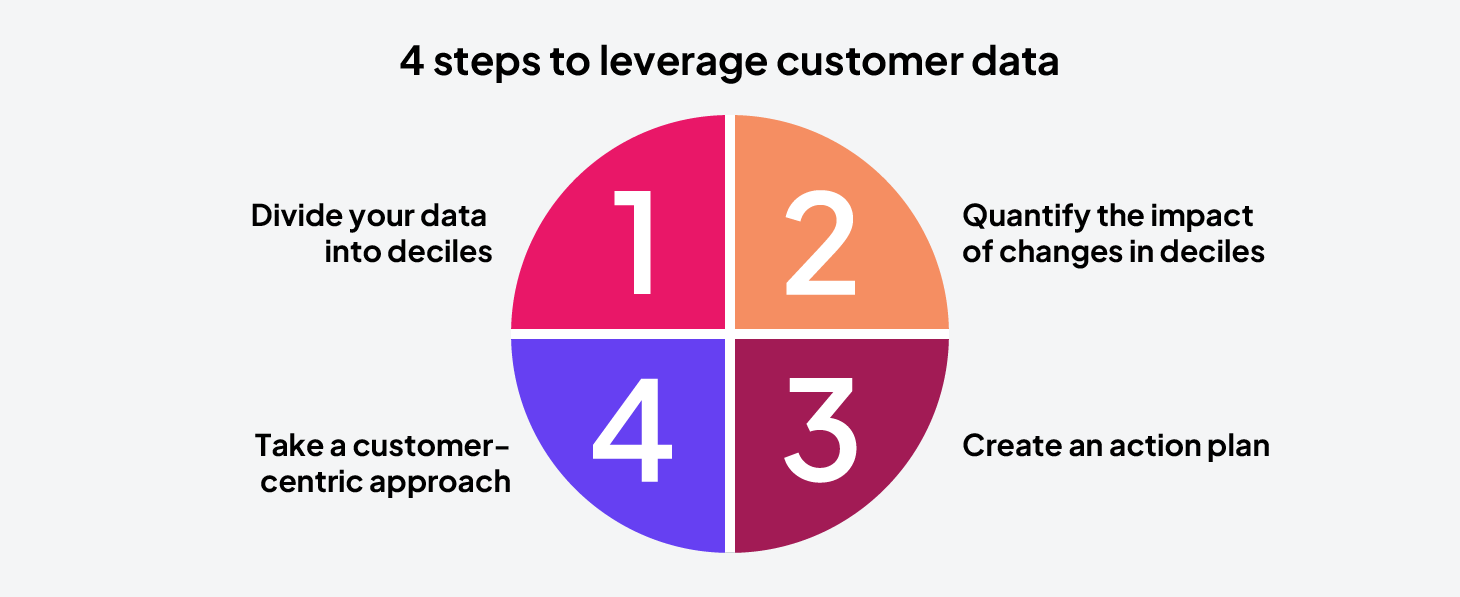
1. Divide your data into deciles
Richard Schenker, Founder & Chief Customer Engagement Officer at Loyal Strategy Consulting recommends dividing your customer loyalty data into deciles as the first step to leveraging your first-party customer data. Deciling is a quantitative method of splitting up a set of customers by value contribution into 10 equally sized customer groups ranked from largest to smallest.
In each decile, you can compare key metrics such as (but not limited to):
- Frequency of spend
- Average order value
- Gross margin dollars
- Full price versus discount purchase proportionality
- Percentage of ‘oncers’ (buy once and don’t come back)
- Private-label purchase penetration
2. Quantify the impact of changes in deciles
Once you have your deciles defined, you can then measure the potential impact of changes within or between deciles. This data is extremely helpful to gain insights on where the biggest opportunities for growth are and where you should invest for the greatest impact.
Here are a few exercises to give your calculator a workout:
-
Retaining your top 10%
These are usually your most valuable customers that generate most of your sales. Even a small attrition of customers, such as 1% from that top decile can make a huge negative dent in your revenue and profitability. An effective retention program is critical to avoid losing these most valued customers. -
Moving customers to higher tiers
How much would sales increase for every 1% of decile 2 that you might be able to move to decile 1? What about if you could move 5% of Decile 3 to Decile 2 spend and frequency levels? And so on. -
Moving the needle on specific behaviors
What would the potential revenue impact be if you could get a fraction of oncers to make a second purchase or increase the frequency of lower deciles?
3. Create an action plan
After you’ve quantified the revenue potential of targeting specific deciles and behaviors, it’s time to put it all together in an action plan that outlines the:
-
Prioritized outcomes (for example, migrate a portion of decile 2 to decile 1)
-
Financial impact of these actions (for example, every 1% movement from decile 2 to decile 1 = $500K)
-
Campaign strategies and tactics to drive these actions (for example, frequency-based, time limited campaign offers)
4. Take a customer-centric approach
Richard recommends that brands use zero-, first- and second-party data to build personas around cohorts of customers that share similar characteristics. The way you speak to and market to each of these needs to be different.
For example, if you sell sports and athletic gear and apparel, you might assemble the following customer cohorts based on zero-, first- and second-party data:
-
Time-starved—You value health & wellness but need it to fit into your busy schedule, convenient and easy work best for you
-
Price Sensitive—Your health is a priority, but your budget is tight, so you can’t afford expensive clothes and equipment—discounts are a key motivator
-
Price Insensitive—Sales don’t motivate you, quality and experience do, and having a high-end brand label makes you feel good
-
Outdoor Fan—Any activity you can participate in that’s outdoors, and you’re in
-
Health Obsessed—You ‘re always interested in new workouts, gear and tips on how to stay healthy and fit
For each cohort, possible data points to capture and compare to the overall member base might include:
- Gender breakdown
- Age distribution
- Annual spend
- Average order value
- Average frequency
- Tenure
- Percentage of total member base
- Top 3 categories purchased (footwear, clothing, accessories, sports-specific)
- Key observations, opportunities & possible tactics to expand/grow
Once you have a clear understanding of your cohorts, you can come up with specific, targeted strategies and tactics to move specific ones from a lower value to a higher value decile. For example, take our Health Obsessed cohort we mentioned above, we’ll call him Health Obsessed Harry. You could create offers, content and promotions around his avid interest in the latest and greatest tips, workouts and gear, such as:
- Sharing the latest research on how to maintain optimal fitness
- Hosting events featuring the hottest workout gurus
- Providing incentives to try the latest, innovative gear
These are some tactics that can be deployed to create a more engaged and meaning relationship with the sports and athletic gear brand.

Trait #3: The program makes it easy to join & participate
According to Statista, the most disliked aspect of loyalty programs according to U.S. consumers is it takes too long to earn rewards. And Ellen Green, VP of Loyalty Strategy at Bounteous, shares that overcomplicating the experience is one of the easiest ways to make a loyalty program fail. Her favorite consumer research quote? “Unless the reward is as spectacular as getting a 1:1 sing-along with Taylor Swift, chances are I won’t jump through hoops for it.”
StratLX’s Andréanne Rondeau advises brands to build an onboarding journey with clear, upfront value communications to help ensure long-term success and engagement. Providing simple and attainable ways for customers to earn and clearly communicating the value, not only ensures a good understanding of the value proposition but also drives engagement right from the beginning.

According to Ascendant’s David Slavick, research shows that any kind of gotchas or restrictions are disappointing to members. He recommends that brands design a loyalty program that’s easy to join, easy to understand as well as easy to earn and redeem rewards. Members should be able to quickly and easily understand what they can earn and how to earn it. This transparency builds trust and encourages participation.
Tandem Theory’s David Mansfield shares that this transparency extends to ensuring members can easily understand their balance and how they can get to the next reward or level, keeping it aspirational. Frictionless is key, including members’ ability able to redeem rewards through any channel. Brands need effortless reward program management capabilities, such as those provided in Annex Cloud’s omnichannel promotion engine, to provide the flexibility both they and their members’ need. Loyalty & Reward Co.’s Philip Shelper says there’s a trend towards going app-first with loyalty programs but cautions these programs are seeing lower penetration than those that give customers a range of ways to join and engage.

Trait #4: The program delivers value day one
First impressions count. The faster new members can earn and redeem rewards, the more likely they are to continue engaging with your brand and the higher the probability of them becoming a loyal customer. In fact, members who are able to redeem within the first 90 days will spend 10 times more than those who don’t. This taps into a psychological phenomenon mentioned in a Loyalty & Reward Co. blog called Endowed Progress Effect, in which individuals are more inclined to engage with a loyalty program once they’ve made initial progress. Early engagement and recognition can have a significant impact of long-term program participation and customer value. And an engagement-driven loyalty platform, like Annex Cloud’s Loyalty Experience Platform, gives you plenty of ways to engage members right out of the gate.
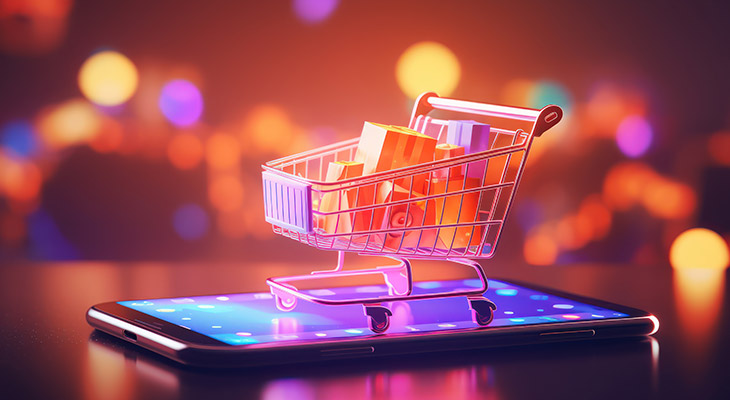
Concentrix Catalyst’s Jodi Rausch recommends rewarding new members as soon as they sign up—but not with points. Points are definitely preferable to monetary discounts since the value of points requires future purchases to get to a reward or to use one (versus just giving away margin which is more likely to result in one-and-done purchasers and drive down active rate). She stresses that there are plenty of ways to provide members with added value that don’t involve giving away margin.
Jodi works with her clients to think of ways to provide non-monetary value to members while remaining true to the brand and the program. This may include things like surprise and delight (not everyone will receive something upon signup), sweepstakes entries, unlocking gated content or member-only products, or an offer code for a partner product (like a free coffee or a kindle download).
Remember, value is subjective
Loyalty & Reward Co.’s Philip Shelper reminds brands to consider the subjective value of these two types of rewards:
-
Inefficient rewards—This provides value in the form of member savings and costs the company money, such as with a gift card
-
Efficient rewards—This is where the member perception of the value is much higher than the actual cost, such as an empty airplane seat or vacant hotel room
Annex Cloud’s Erin Raese recommends that brands offer members a variety of ways to earn as well as a range of rewards, so they can select options that align with their interests and preferences. This gives them the chance to explore new services and brand interactions, resulting in a more personalized experience. While discounts and cashback are popular, consider experiential rewards like exclusive access or early product launches. Again, this is where effortless reward program management can make a big difference.
Trust and affinity must be earned
Ascendant’s David Slavick stresses the importance of brands remembering that they have to earn brand affinity. This means it’s not a good idea to send a brand-new loyalty member a request to refer a friend right after they sign up. A better idea might be to send that new member a survey asking them about their signup experience and incentivizing them to participate in the survey.
Building trust is equally important. According to Bounteous’ Ellen Green, getting to know the customer better is a great way to show value early in the relationship. Incorporating zero-party data capture into customer onboarding powers personalized experiences and creates trust from the beginning by showing members you’re using their data to serve up personalized recommendations, offers and promotions.

Trait #5: The program value is clear
When delivering a presentation, it’s best practice to tell your audience what you’re going to tell them, tell them, then remind them of what you’ve told them. This reinforces the key points and value of the presentation and helps your audience remember what they heard. The same goes for your loyalty program.
Onboarding is essential
Consumers have very busy lives and get bombarded with marketing 24/7. It’s not enough to simply show the benefits of your loyalty program on your website. According to R3’s Hans Laroche, few loyalty programs have set up a detailed onboarding strategy that clearly explains program features and quickly engages members. He recommends keeping the post-enrollment going with an onboarding strategy that clearly explains program benefits, offers rewards for completing member profiles and rewards members quickly to engage them immediately.
Don’t assume your customers know everything about your loyalty program. Regularly communicate the benefits and any updates through email, social media, mobile and your website. Tandem Theory’s David Mansfield puts it this way, “Signups lead to engagement, engagement leads to loyalty. It’s a journey, so going beyond signups and having a clear, consistent way to communicate is critical.”
Fortunately, your loyalty program provides plenty of opportunities to communicate the value of your program. Here are a few ways you can keep the value of your loyalty program front and center for members:
-
Send emails and/or text messages showing them how close they are the next tier or reward
-
Show them how many points they earned/used over a given timeframe
-
Show them how many rewards they’ve redeemed to-date
-
Remind them of how much they’ve saved through loyalty member discounts and promotions
-
Remind them of all the ways they can earn points
-
Remind them of earned points that are expiring soon
-
Display the points they’ll earn if they purchase specific items
-
Offer and promote exclusive benefits they only get because they’re a loyalty member
-
Inform them of new benefits and offers available to them as a loyalty member
Celebrating milestones is a great way to remind members of your loyalty program’s value. Ascendant’s David Slavick suggests recognizing and potentially rewarding members for anniversaries, hitting the next tier or becoming a top-tier member. The unfortunate reality is most brands don’t do this. There are plenty of opportunities, such as in a member’s profile or dashboard, to remind them of how much they’ve earned and saved, as well as reinforce any new or exclusive benefits they’re now eligible to take advantage of. David shares CVS as an example of a brand that does a great job of continually reinforcing their loyalty program’s value proposition.

Trait #6: The program goes well beyond transactions & discounts
Points are great but everyone offers points. Today’s consumers want more than transactional relationships with brands. You might be surprised to learn that a 2022 Statista survey found that roughly 50% of participants reported joining a loyalty program simply to express their devotion to a brand. A loyalty program is the best way to take your customer relationships beyond purchases.

According to Andrew Kelly, Managing Partner at Hydrate Loyalty/Salient Global, while today’s consumers yearn for a deeper connection with brands, emotional loyalty is still mostly an aspiration for many organizations, given an overwhelming reliance on transactional data. Creating and delivering experiences that bring real value and utility to the customer—whether that’s tapping your zero- or first-party data and data-driven loyalty analytics to serve up richer, more tailored personalization at the individual level, or extending the loyalty experience to your partner ecosystem in ways that drive meaning and value—are key in building longer-term brand loyalty beyond the transactional level. Ascendent’s David Slavick shares that unique merchandise, branding, events, private invitations, private shoppers, badges, leaderboards, cause marketing, Environmental / Sustainability / Governance (ESG) initiatives all have nothing to do with making a purchase and everything to do with building brand affinity.

Brands need to address both behavioral and attitudinal loyalty
Loyalty & Reward Co.’s Philip Shelper advises his clients that the foundation of loyalty starts with commitment. To create the strongest commitment between brand and consumer, brands need to address both behavioral (shop consistently) and attitudinal (emotional) loyalty. Brands that only address one or the other are vulnerable to quick customer shifts.
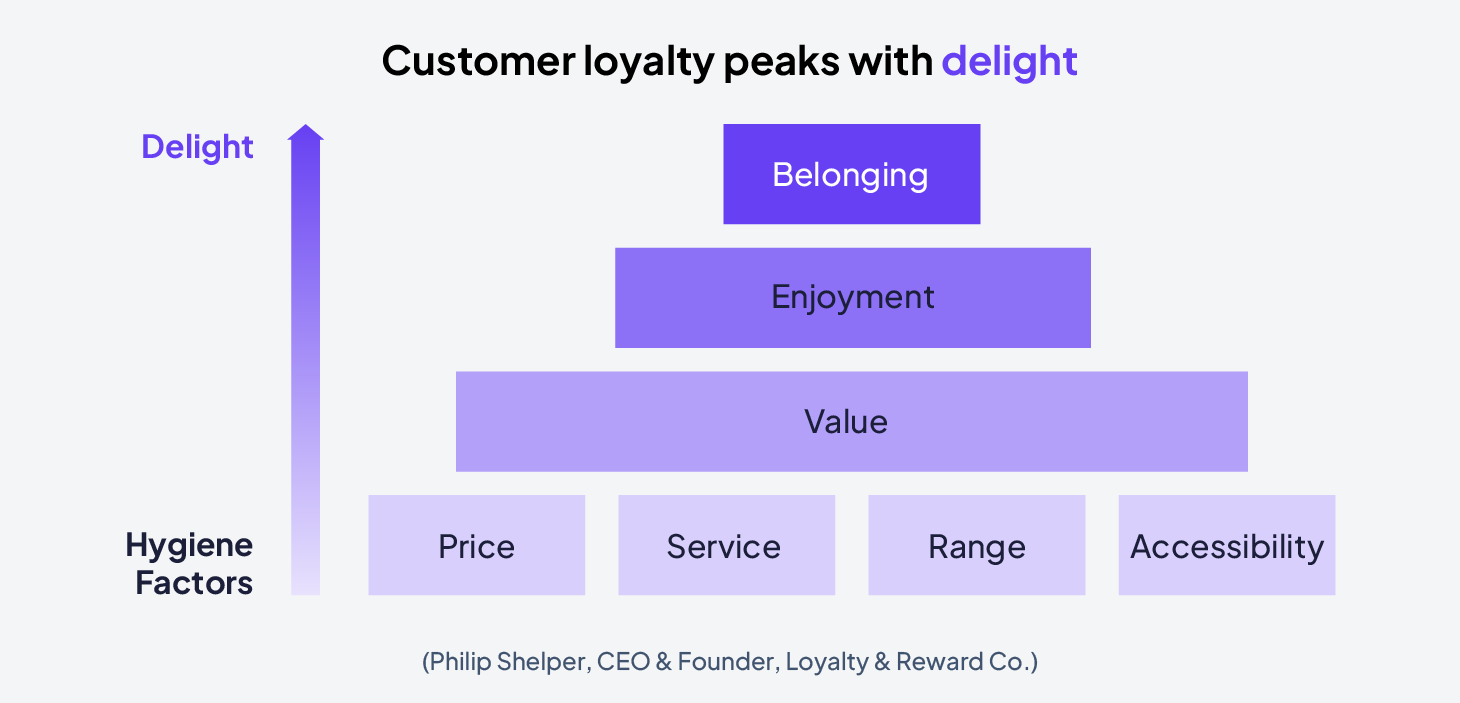
Philip shares that most loyalty programs focus primarily on hygiene factors. But as humans, we have a need for self-esteem. Everything from our job, social groups, sports teams—even the brands we associate ourselves with—can boost our self-esteem and make us feel good about ourselves. We may even adopt the brand as part of our personal identity. Think driving a Mercedes or wearing Prada. Emotional engagement creates attitudinal commitment. Your brand can build attitudinal commitment with non-transactional engagement, recognition and rewards that help build emotional bonds with members. This is where a scalable, flexible engagement-driven loyalty platform can be invaluable.
Here are a few tactics to consider adding to your loyalty program.
Exclusivity & community
We all want to belong to something beyond ourselves. And fear of missing out (FOMO) is a huge motivator. What can you do to make your loyalty members feel special and give them the sense they’re receiving special or exclusive rewards? If you’ve ever been a frequent flyer and enjoyed boarding first or relaxing in the members-only lounge beforehand, you know how powerful these exclusive benefits are and how they lead to a closer affinity with the brand.
Consider offering things like early access to new products, invitations to private shopping events, reserving sizes that go out of stock quickly or following in the footsteps of Famous Footwear by letting members pick their own sale day. Customers who feel special and recognized are more inclined to actively engage in your program and are more likely to make frequent and larger purchases, speak favorably about your brand and become brand ambassadors.
According to StratLX’s Andréanne Rondeau, well-designed tiers bring a sense of exclusivity and added value for your most valuable customers. They offer clear objectives to strive for and award exclusive benefits and rewards. Tiered loyalty programs enable your brand to recognize, engage, and reward customers in line with their spending and brand engagement, making economic sense. By tailoring benefits and rewards according to each customer’s value, you can maximize the effectiveness of their marketing investments, deliver a meaningful experience for members and yield a substantial impact on the bottom line.
Shared values
Today’s consumers, especially GenZs, seek out brands that have ESG initiatives. Whether it’s donating a percentage of every sale on behalf of members, giving employees a volunteer service day, or serving up on-brand benefits like Orvis that gives 5% to nature and canine health organizations—more and more brands are being transparent about their values and demonstrating how they’re living those values every day. Making your values clear, being authentic and being consistent is a great way to build lasting emotional bonds with members.
Sephora launched Beauty (Re)Purposed, taking back packaging from any brand and recycling it to reduce hard-to-recycle packaging waste. Ulta’s Conscious Beauty program boasts 300 brands that meet at least one of five program pillars that include clean ingredients, cruelty-free, vegan, sustainable packages and positive impact. H&M introduced Tess Holliday, a model and influencer in the size-inclusive space, as a consultant and has expanded its plus-size collection.

Partnerships
Concentrix Catalyst’s Jodi Rausch shares that partnerships are exploding right now, with more and more brands finding new ways to leverage partnerships, connections and sponsorships. According to The Point of Loyalty’s Adam Posner, partnerships are key to a loyalty program providing relevant offers and benefits outside of a brand’s internal reward ecosystem. They’re often low cost (partner funded) with the potential for high perceived value. This strategy, while not new, is gaining more momentum as programs continue to look for an edge to be different and add more value to their members.
Trait #7: The program makes loyalty fun
Tom Peace, Managing Director at The Loyalty People sees two loyalty trends that are really important right now—making loyalty fun, and experiential rewards and content. Both require a modern engagement-driven loyalty platform to pull off.
Gamification
According to Tom, brands like Duo Lingo are really leading the ‘game’ on gamification and many health and beauty brands, such as Sephora, have capitalized on content to create an emotional connection through experiences. Ascendant’s David Slavick shares that sports are a great place to look for inspiration. Sports fans are extremely passionate. They eagerly share their favorite team, favorite player, first time they attended a playoff game or caught a game ball. They even have favorite places to sit. Contests and gamification are great ways to capture unique zero- and first-party data while making member experiences fun and engaging. For example, an Annex Cloud client surveys loyalty members to find out what their favorite sport is as well as their favorite athlete within that sport. Every time that athlete scores, the member gets an email notifying them to claim their reward points.
Experiential benefits
In her podcast episode, What It Means: What’s Next for Customer Loyalty, Forrester VP and Principal Analyst Mary Pilecki shares that experiential loyalty is one of three trends identified by Forrester. According to Mary, in the ‘80s and ‘90s, loyalty was all about financial rewards—including instant discounts, free samples and earning currency, such as points. Today’s consumers still want these—but they equally want experiential rewards. These provide unique ways for your brand to connect with customers on a deeper level and may include better customer service, having their feedback acted on, preferred services and early access to new products. Mary reports that, more and more, loyalty members join programs because they want to feel special, and they want offers and promotions that aren’t available to everyone. Brands that deliver experiential benefits are rewarded with the three major outcomes of loyalty—retention, financial enrichment and advocacy.
Gartner shares a few examples of both B2C and B2B experiential benefits:
-
Michael Kors KORSVIP Rewards Program includes early access to sales for every rewards tier, while in-store events and early access to special products are reserved for the top two tiers. The top tier, Red Carpet, also includes access to exclusive VIP experiences
-
Shangri-La Hotels and Resorts revamped loyalty program, Shangri-La Circle, offers several experiential rewards that increase with higher reward tiers, including guaranteed room availability for reservations made prior to arrival, early check-in and late checkout.
-
Henry
Schein’s B2B Dental Equipment Rewards Program, Thrive Rewards, has four tiers and a comprehensive set of both experiential and transactional rewards. Experiential rewards include priority scheduling, guaranteed emergency response time for service and personal concierge service with a VIP Account Representative. -
Caterpillar’s Cat Rewards is a B2B loyalty program that incentivizes purchases of qualifying Cat products and services for points that can be redeemed for a variety of rewards—including physical items like electronics and Cat branded apparel and appliances, as well as experiential rewards, including travel experiences and tickets to sporting events.
Trait #8: The program stays fresh and is always evolving
Bounteous’ Ellen Green shares that one thing top loyalty programs all have in common is they evolve over time. There’s no set it and forget it. As customer needs change, economic conditions change, brands need to change too. It can be as simple as adding benefits that give access, exclusivity, surprises, fun or ease to keep the program fresh or as large as updating the value proposition based on the needs of the customer, business or brand. An Annex Cloud client changes promotions and rewards every month to keep things interesting. The key is to continually analyze and adapt your program to meet evolving customer expectations and market trends. That way, you can ensure your loyalty program remains effective and competitive.
StratLX’s Andréanne Rondeau adds that loyalty strategies need to keep evolving, and successful programs have roadmaps that are adapting to customers’ needs. Starting from the initial strategy design, companies need to envision the program’s future, its evolution, and refine the value proposition as they gain insights into their customers and mature in their loyalty approach.
Constantly monitor the performance of your loyalty program. Use key performance indicators (KPIs) like customer retention rate, average transaction value and customer lifetime value to assess its impact. Adapt and refine your program based on these insights. Testing is your friend—try out potential changes on a micro-segment before rolling them out to the masses.
According to Forrester’s Mary Pilecki, research shows customers will adjust to program changes if the value exchange is still strong enough. In her blog, Changing Your Loyalty Program? Here’s What to Consider, Mary recommends the following steps for brands looking to change their loyalty programs:
Talk to and listen to your customers
Conduct research first to understand what customers like and don’t like about the program. They’ll tell you what they want.
Be transparent
Carefully consider your program change messaging. Communicate openly with members before, during and after changes.
Focus on your most loyal customers
Identify your ‘devotees’ and include them in your research and find promotional ways to make these members feel they’re still valued.
Prepare internally
Plan your approach to anticipated consumer responses based on the degree of program change. Educate and equip customer-facing employees with scripts and tools.
Stay adaptable
Remain flexible and be prepared to help members adapt to loyalty changes. Prove to your customers that you care by being open and available to them.

Trait #9: The program leverages SaaS technology
Loyalty technology has come a long way in the past decade. And, according to Forrester VP and Principal Analyst Mary Pilecki in her blog, Flexible Loyalty Technology Solutions Power Profitable Loyalty Programs, 53% of B2C marketing decision-makers plan to increase their spend on loyalty technology this year. Mary says enterprises need “a technology solution that effectively and efficiently supports the program, fits into the brand’s martech ecosystem and enables agility as brand and customer needs change.”
Experts advise brands to invest in a robust engagement-driven loyalty platform, preferably a SaaS loyalty solution, that enables effortless reward program management and data-driven loyalty analytics. This will help you effectively track customer behavior, preferences and program performance. Global enterprises typically turn to custom loyalty solutions based on the assumption that their needs are unique or too complex—but today’s SaaS loyalty platforms are surprisingly robust, flexible and agile enough to satisfy most enterprise loyalty requirements.
5 must-have loyalty platform capabilities

1. Collect, analyze and act on customer data
Collecting customer data isn’t enough. Your brand needs to be able to effectively act on that data to personalize member experiences and drive growth. To turn member data into member actions that deliver results, your loyalty platform should have:
-
Advanced segmentation capabilities—including the ability to select and rank key customer segments to find your best customers, biggest spenders, newest customers and those ready to churn
-
Enterprise-ready data management capabilities—including a secure global infrastructure, the ability to integrate product and store data into your loyalty program, data privacy, security
-
An intelligent rules engine—that allows you to dynamically configure an infinite combination of controls for points, tiers, actions, rewards and campaigns
2. Be more than a points engine
For your brand to take your customer relationships beyond transactions, you need a loyalty platform with robust next-gen capabilities that span the entire member journey. This includes features and functionality that:
-
Engages members—from program signup, interacting on social media and participating in surveys or quizzes to writing reviews and scanning receipts
-
Personalizes experiences—by leveraging progressive profiling and advanced segmentation
-
Retains your best customers—by combining the right program types and features, using gamification and being able to choose from a wide range of incentives and rewards
-
Drives advocacy—by recognizing and rewarding members for promoting you on social media and referring others
3. Maximize your flexibility, adaptability and configurability
Today’s SaaS loyalty solutions give your brand the freedom to respond and adapt quickly to changing customer, market and business needs. The more mature and sophisticated your enterprise gets, the more sophisticated your loyalty platform needs to be—especially in terms of how granular and custom you can get within various segments. For example, you might need to vary how individual groups or segments earn points, or when those points expire. Annex Cloud’s loyalty rules engine gives brands enormous adaptability in program rules and design.
Your loyalty platform should also enable you to:
Test and learn
If the program doesn’t stay fresh and continue to innovate, it’ll fall behind the competition and decline in performance. You need the ability to test new segments, benefits, promos and rewards and quickly see what is and isn’t working, then adjust accordingly. Waiting for lengthy development every time you want to try something out is both frustrating and costly. SaaS loyalty platforms empower marketing teams to change segments, promos and more on the fly.
Expand across regions and brands
Most enterprises are global and have multiple brands—but it can be challenging to easily replicate their loyalty program across regions and brands while still allowing for localization in currency, language, culture and other brand-specific nuances. Annex Cloud’s multi-template functionality makes it easy for organizations to copy, then customize, loyalty programs to align with specific regions and brands.
Go-to-market quickly with updates and changes
Most legacy loyalty solutions were built for a single point in time—but the needs of your brand and customers are always evolving. Your loyalty platform should allow you to easily and quickly adapt to changing needs without waiting on your IT or development team. SaaS loyalty platforms allow you to easily set rules, customize and change in minutes, so you can take advantage of opportunities in real time.
4. Scale without limits
Legacy and custom loyalty solutions can sometimes limit your brand’s ability to expand and grow. SaaS loyalty solutions are designed to accommodate growth. Annex Cloud’s Loyalty Experience Platform allows you to add unlimited members, unlimited custom attributes and easily expand your loyalty program across brands and regions.
5. Deliver personalized, omnichannel experiences
If you’re like most enterprises, you have a complex tech stack that includes ecommerce, POS, CRM, ESP, CDP, SMS and more. The ability to share customer data across your ecosystem is critical to your growth strategy and your ability to deliver personalized experiences but, according to Gartner, less than 10% of companies have a 360-degree view of their customers and only 5% can use a 360-view to systematically grow their businesses. And most brands are still unable to allow members to redeem rewards via any channel.
Annex Cloud’s 125-plus integrations seamlessly push robust zero- and first-party customer data across your organization, enabling you to personalize every touchpoint. And our omnichannel promo engine allows you to reward member actions with just about anything while allowing loyalty members to earn and redeem rewards no matter where they engage with your brand.
“Loyalty is the outcome of great experiences, no matter where customers are. Some brands literally meet customers where they are—like Domino’s with their new Hotspots technology by delivering pizza anywhere. Others adopt new emerging channels or leverage AI to fuel personalized experiences at scale.”
– Ellen Green, VP Loyalty Strategy, Bounteous
Bonus trait #10: The program makes financial sense
One of the primary goals of a loyalty program is to drive, not just growth, but profitable growth. The Mallett Group’s Steve Sickel stresses that a successful loyalty program should be financially viable—both now and in the future. He often sees programs that don’t consider the fully-loaded costs of running a loyalty program and are under-water from the start—or are financially viable at launch but aren’t built in a way that absorbs and flexes with changes in costs (even just simple inflation). And when you’re not able to absorb and adjust modestly or incrementally over time, you’re forced to make dramatic changes that can erode customer trust and cause customer disengagement.

The 9 traits in action
For the past six years, R3 Marketing (now part of Adviso, a leading Canadian consulting agency) has conducted The LoyalT Study—the most comprehensive annual research on loyalty programs’ trends and performance in Canada. The 2023 study evaluated 83 Canadian loyalty programs across 10 industries—and took the pulse of 10,000 Canadians on usage trends and their perceptions of which programs offer the most value.
A unique methodology is used based on what they call the LoyalT score—which is composed of three indices:
-
Engagement—Members use app, use card, redeem, etc.
-
Behavior—Capacity to change member behavior i.e. increase frequency, change purchase to get benefits, etc.
-
Affection—Attachment, personalization, relevancy, ease
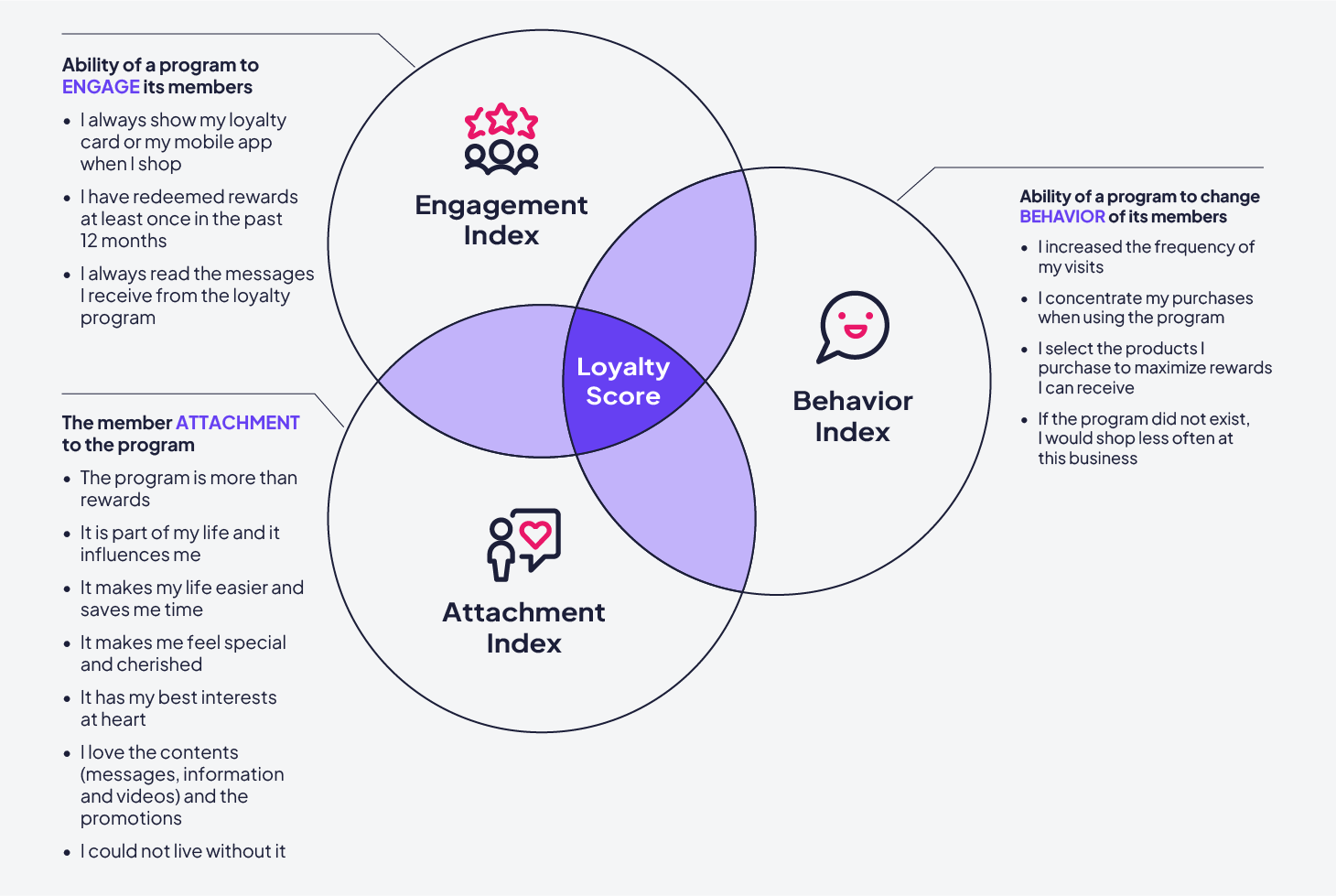
This year, they also considered a new communication score based on:
-
Frequency of communications
-
Regularly consulting program offers
-
High assessment of content
-
High level of personalized content and offers
Top 5 loyalty programs
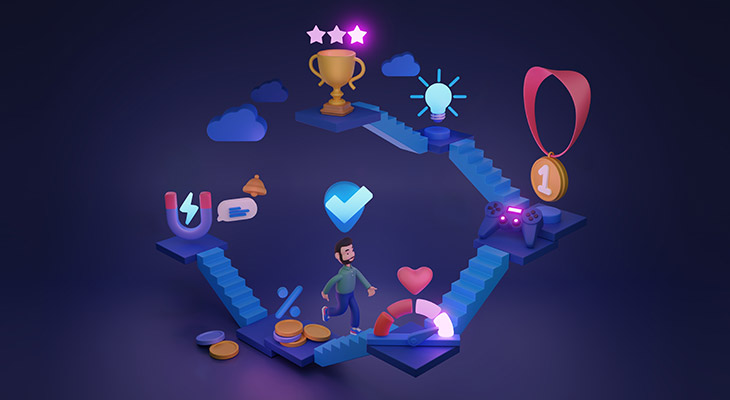
According to R3’s Hans
Laroche, some of the top programs have ranked since the launch of LoyalT in 2017. These consistently ranking companies most likely consider their loyalty program to be at the very heart of their success and perceive the program as a real investment instead of a cost center.
While the details vary, all these top-performing companies:
-
Use A/B testing
-
Optimize their mobile experience
-
Try new features Improve their email marketing strategies
-
Increasingly customize offers and content
Here are five of the top 10 ranked loyalty programs in Canada—all brands you’ll recognize. You can get an executive summary of the 2023 LoyalT Study here.
1. Chipotle Rewards
Chipotle Rewards delivers value out of the gate by giving new members free guacamole for signing up. Their program’s Extra feature allows members to earn free food faster (tongue twister alert!) and gamifies the loyalty experience with personalized challenges to earn extra points and collect achievement badges. Members can redeem points for free menu items, apparel and more through the Rewards Exchange. Members can also redeem points to support non-profit partners—including The Farmlink Project, the National Young Farmers Coalition and the National Urban League. The program boasts more than 24 million members and has helped Chipotle shift toward digital sales, a crucial lifeline during the pandemic. “Offering new ways to engage with Chipotle is essential to the ongoing evolution of our digital business,” said Chris Brandt, Chipotle’s chief marketing officer.
2. Starbucks Rewards
Starbucks Rewards members earn stars with each purchase that they can redeem for free coffee and food deals, as well as members-only extras—including express order and pickup. Starbucks was the first loyalty program made available through a mobile app—giving members unprecedented ease and convenience. Members can add alternative payment options and receive unique giveaways and discounts as they accrue stars. Members also receive free in-store refills on coffee and tea. “With over 24 million active members now representing 51% of all spend in our U.S. stores and up 8 percentage points over pre-pandemic levels, our ability to engage has never been higher,” said CEO and president Kevin Johnson.
3. Domino’s Rewards
Domino’s new and improved program gives loyalty members even more opportunities to earn and redeem points. Members now earn 10 points on every $5+ order and can redeem points for even more menu items. They also earn free Domino’s after just two orders. The program rules are simple. They offer exclusive access to member-only deals. And members get special discounts and opportunities to earn bonus points. “We are thrilled to give the brand’s loyal customers additional ways to earn free Domino’s items more often,” said Mark Messing, Domino’s vice president of digital experience and loyalty. “At a time when most brands are scaling back their loyalty programs and making it more difficult to earn and redeem points, Domino’s is doing the opposite. We want to make it easier to reward our customers and give them more options so they can get rewarded faster.”
4. Sephora’s Beauty Insider
Sephora’s Beauty Insider Program checks off all the boxes thanks to its simple, yet flexible and creative benefits that cater to customer interests. Members earn one point for every dollar and get $10 off a qualified purchase when they hit the 500 mark. Tiers unlock progressively better benefits—such as first access, exclusive gifts and free shipping. And non-transactional perks, including access to beauty classes, exclusive collections and community events help build that emotional connection.
5. MyMcDonald’s Rewards
McDonald’s Rewards lets members earn and accumulate points with every purchase, and everything is done via the chain’s mobile application. Members earn 100 points for every $1 in purchases that are redeemable for delicious free rewards. Reward levels start at 2,000 points and points accumulate fast. There are five tiers of free rewards—each offering access to different free items. The program is simple for members to understand and participate—the rewards that match your points balance are clearly visible and you can easily add them to your order. You can use deals in-store or the drive-thru, or pay via the mobile app.

Our Experts’ Top Picks
The North Face XPLR Pass
Jodi Rausch, Managing Director, Loyalty Solutions, Concentrix Catalyst
XPLR Pass is a beautiful expression of what The North Face is and stands for:
-
Adventure and Exploration: Members-only gear, members-only field testing, and members earn points for checking in on the app at National Parks— also loyal customers sometimes get the chance to test unreleased products in extreme outdoor conditions. This adds an extra element of exclusivity and adventure.
-
Sustainability: Members earn points for shopping with a reusable bag and receive $10 credit when members donate their used North Face products to The North Face Renewed Take-Back Program
H&M Now
-
Erin Raese, SVP of Growth & Strategy, Annex Cloud
H&M Now is free to join and members instantly get 10% off their first purchase when they join. Members earn one point for every dollar spent. Members can also earn points by making conscious choices—including recycling clothes and bringing their own bag to the store. For every 200 points earned, members receive a $5 gift voucher. Reaching 500 points makes you a Plus Member, giving you access to higher-level rewards and perks—including free shipping, surprise offers, exclusive discounts and special access to limited collections.
Sephora Beauty Insider
-
Ellen Green, VP Loyalty Strategy at Bounteous
Sephora’s loyalty program emulates all 9 traits: adding new benefits each year to evolve, creating personalized recommendations, making it simple with easy refill messages, meeting customers where they are in-store, at home, digitally, through delivery and engaged employees, going beyond the transaction to give unique experiences like makeovers in-store or virtually, creating a community and delivering value with every interaction whether it be through points, advice, samples or seamless experiences. -
Jodi Rausch, Managing Director, Loyalty Solutions, Concentrix Catalyst
There are a number of things I like about the Sephora program that I think warrants a best-in-class moniker. I like how they’ve treated their tiers. Not only are the tiers separated by reasonable spend differences, but the ‘plus-up’ of benefits at each tier is commensurate to the additional value the elite member brings to the brand. Achieving elite tiers shouldn’t be too easy, nor should the higher tier benefits feel unrewarding in return for so much spend. With the exception of Rouge members being able to redeem points for a monetary reward, all point redemptions are for products. Not just any products, like toasters, luggage or gift cards, but products Sephora actually sells. This encourages product trial and exploration which is very on-brand for Sephora and is widely loved by their members.
Starbucks Rewards
-
Ellen Green, VP Loyalty Strategy at Bounteous
Starbucks Rewards has a delightful hidden surprise. When you reach over 400 points, your points tracker turns to gold glitter and animates. The first thing I did when I learned this was accumulate more than 400 points. -
Jodi Rausch, Managing Director, Loyalty Solutions, Concentrix Catalyst
Starbucks Rewards is a solid program with great benefits (especially pay through the app and mobile ordering) and the ability to redeem for add-ons and products is fantastic. But it’s the Starbucks Odessey program that’s especially innovative, delivering a very compelling Web3 experience to Starbucks Rewards members—from interactive journeys and challenges to the gamification aspect, and the ability to earn points for truly one-of-a-kind benefits. I appreciate the deeper brand experience of Odessey and exclusive feel of the adventure.
Your loyalty program, when done right, can significantly improve financial performance while taking your customer experiences to a whole new level. Use these nine traits as a helpful checklist to assess your current loyalty program to identify where it’s performing well, and where you should look to make improvements.
Annex Cloud is here to help you make your loyalty program the best it can be—for both you and your customers.









